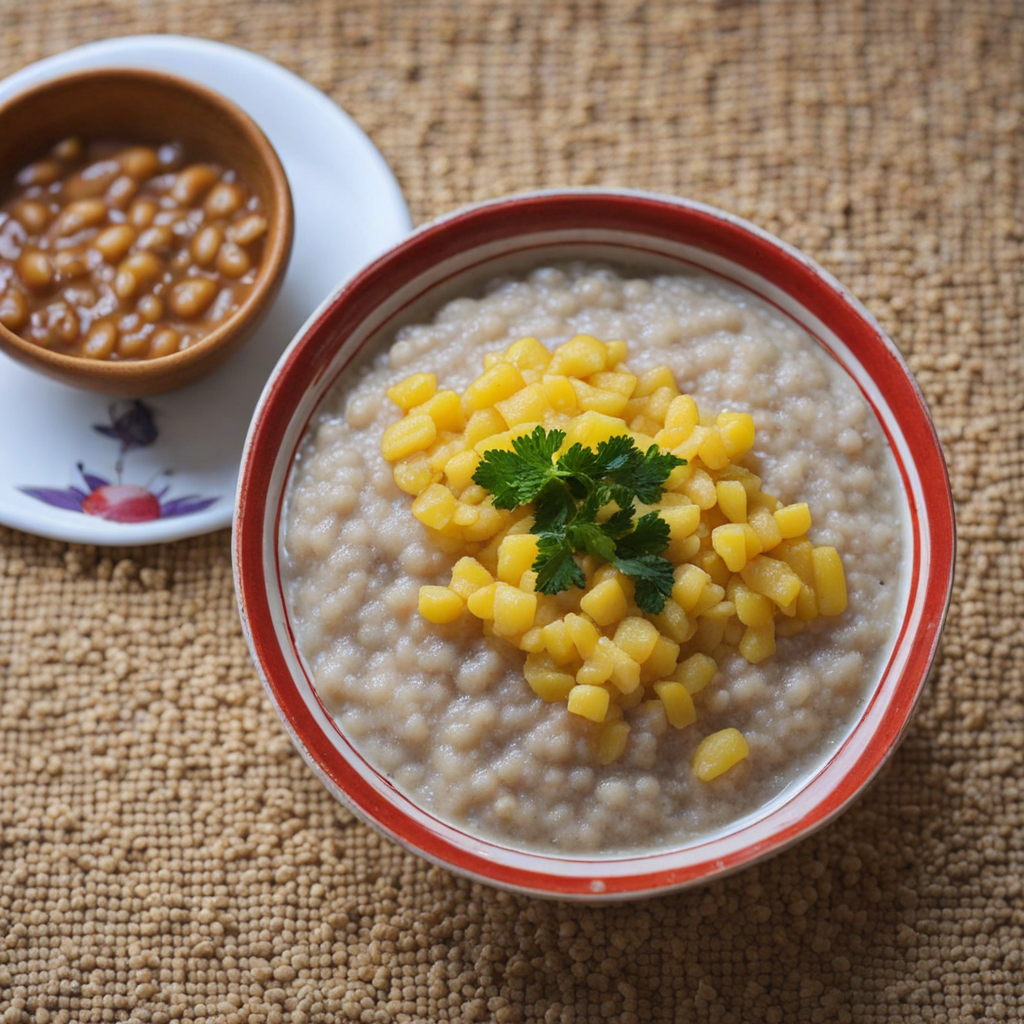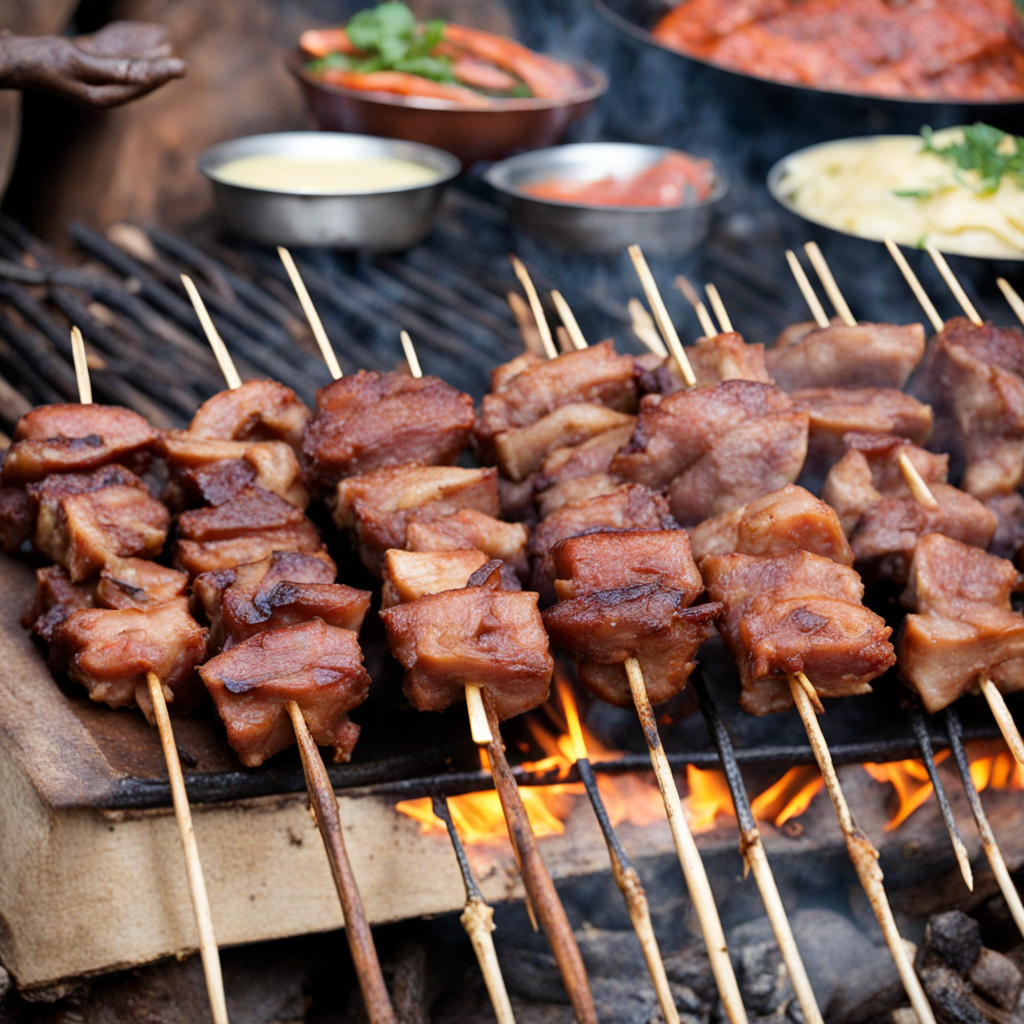Urunyogwe
Urunyogwe is a traditional Rwandan dish that highlights the rich agricultural heritage of the country, primarily featuring the sweet potato as its star ingredient. This dish is characterized by its unique blend of flavors and textures, combining the natural sweetness of the potatoes with a variety of spices and seasonings. The sweet potatoes are usually boiled or steamed until tender, resulting in a creamy base that serves as a canvas for the accompanying ingredients. The vibrant orange and yellow hues of the sweet potatoes not only make for an appealing presentation but also indicate their high nutritional value, as they are packed with vitamins and minerals. To enhance the dish, Urunyogwe is often complemented with ingredients such as groundnut (peanut) paste, which adds a nutty richness, or fresh vegetables that provide a delightful crunch. Sometimes, it is served with a spicy sauce made from local chili peppers, which offers a kick that balances the sweetness of the potatoes. The combination of these elements creates a harmonious blend of flavors that is both comforting and satisfying, making Urunyogwe a beloved staple in Rwandan households. The experience of tasting Urunyogwe goes beyond just its flavors; it embodies the essence of Rwandan culture and the importance of community and sharing meals. Traditionally enjoyed during family gatherings or festive occasions, this dish invites diners to savor the simplicity of ingredients elevated by thoughtful preparation. As you explore Urunyogwe, you’ll discover not just a meal but a connection to the heart of Rwandan tradition, making it a must-try for any food enthusiast seeking to expand their palate with authentic flavors.
How It Became This Dish
The History of Urunyogwe: A Culinary Heritage of Rwanda Origin and Definition Urunyogwe, a traditional dish from Rwanda, embodies the rich agricultural heritage and cultural tapestry of the Rwandan people. Often made from the indigenous grains such as sorghum or millet, Urunyogwe is primarily prepared as a porridge or fermented beverage. The word "Urunyogwe" itself reflects the essence of its ingredients and preparation techniques, encapsulating a way of life that deeply intertwines food with cultural identity. Historically, Rwanda is known as the “Land of a Thousand Hills,” characterized by its terraced farming and diverse agricultural practices. The cultivation of grains, particularly sorghum and millet, dates back to the early inhabitants of the region. These grains were not only staples of the Rwandan diet but also held significant cultural importance, often being used in rituals and community gatherings. Cultural Significance Urunyogwe is more than just a dish; it is a symbol of community, resilience, and the interconnectedness of Rwandan society. Traditionally, food preparation and sharing have been communal activities, fostering social bonds and reinforcing cultural values. Urunyogwe, in particular, has been a centerpiece in various ceremonies and celebrations, such as weddings, harvest festivals, and family gatherings. One of the most profound aspects of Urunyogwe is its role in Rwandan rituals. The dish is often associated with rites of passage, such as birth and initiation ceremonies, where it is prepared and consumed as a means of blessing and protection. The fermentation process, which gives Urunyogwe its unique flavor and nutritional profile, is steeped in communal practices, with families often gathering to partake in the preparation. This collective effort not only strengthens family ties but also serves to educate younger generations about their culinary heritage. Moreover, Urunyogwe is linked to concepts of hospitality and generosity in Rwandan culture. Serving this dish to guests signifies respect and welcome, showcasing the host's pride in their culinary traditions. The act of sharing Urunyogwe is a gesture of goodwill, often accompanied by stories and laughter, reinforcing community bonds and cultural narratives. Development Over Time The evolution of Urunyogwe can be traced through various historical events and sociocultural changes in Rwanda. Prior to the colonial era, Rwandans relied heavily on subsistence farming, where grains like sorghum and millet were integral to daily life. The preparation of Urunyogwe was primarily a domestic affair, with recipes passed down through generations, each family adding its unique touch. The arrival of European colonizers in the late 19th and early 20th centuries brought significant changes to Rwandan agriculture and food practices. The introduction of cash crops such as coffee and tea shifted focus away from traditional grains, leading to a decline in the prominence of dishes like Urunyogwe. However, the dish remained a staple among rural communities, who continued to value its nutritional benefits and cultural significance. Post-independence in 1962 marked a period of cultural renaissance in Rwanda, where there was a renewed interest in traditional foods and practices. Efforts to revive and promote indigenous dishes, including Urunyogwe, gained momentum as Rwandans sought to reclaim their cultural identity in the face of globalization. Culinary festivals and cultural events began to highlight traditional foods, encouraging younger generations to appreciate and learn about their heritage. The 1994 Rwandan Genocide profoundly impacted the nation, leading to a loss of lives, traditions, and culinary practices. However, in the aftermath, there was a collective effort to rebuild and heal, and food played a crucial role in this process. Urunyogwe, along with other traditional dishes, became a symbol of resilience and unity, often served in community gatherings aimed at fostering reconciliation. In recent years, the resurgence of interest in sustainable and locally sourced foods has further elevated the status of Urunyogwe. As Rwandans embrace their culinary heritage, initiatives promoting traditional agriculture and recipes have gained traction. Organizations focused on food sovereignty and nutrition have recognized Urunyogwe for its health benefits, highlighting its role as a source of essential nutrients and its adaptability to various dietary needs. Contemporary Relevance Today, Urunyogwe is experiencing a revival not only in Rwanda but also among the Rwandan diaspora. Restaurants and culinary enthusiasts are reinterpreting traditional recipes, incorporating modern techniques while maintaining the essence of Urunyogwe. This fusion has opened new avenues for culinary innovation, allowing Urunyogwe to be enjoyed in diverse settings, from formal dining to casual gatherings. Moreover, the global rise of interest in ethnic cuisines has placed Urunyogwe on the culinary map. Chefs and food writers have begun to explore Rwandan cuisine, showcasing dishes like Urunyogwe at international food festivals and gastronomic events. This exposure has sparked curiosity and appreciation for Rwandan culinary traditions, encouraging more people to engage with the cultural narratives behind the food. In addition to its culinary significance, Urunyogwe serves as a vehicle for storytelling. The preparation and consumption of the dish are often accompanied by narratives that reflect Rwandan history, values, and aspirations. As such, Urunyogwe transcends mere sustenance; it is a medium through which Rwandans connect with their past, celebrate their present, and envision their future. Conclusion Urunyogwe stands as a testament to the resilience and richness of Rwandan culture. Rooted in tradition yet adaptable to change, it encapsulates the essence of community, identity, and heritage. As Rwanda continues to evolve, Urunyogwe will undoubtedly remain a vital part of its culinary landscape, reminding both locals and the global community of the enduring power of food in shaping cultural identity and fostering connections among people. Through its flavors and stories, Urunyogwe invites everyone to partake in a journey through the heart of Rwanda, where each bite is a celebration of history, community, and love.
You may like
Discover local flavors from Rwanda







